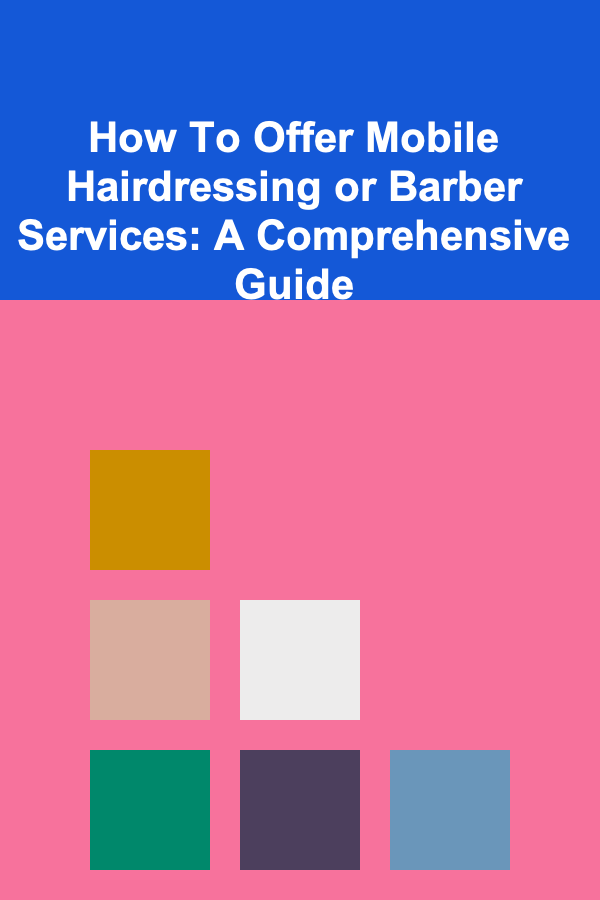
How To Offer Mobile Hairdressing or Barber Services: A Comprehensive Guide
ebook include PDF & Audio bundle (Micro Guide)
$12.99$8.99
Limited Time Offer! Order within the next:

The mobile hairdressing and barbering industry is booming. Increasingly, clients are seeking the convenience and personalized attention that comes with having a professional stylist come to them. Whether it's for busy professionals, elderly individuals with mobility issues, stay-at-home parents, or those simply seeking a more private and comfortable experience, the demand for mobile services is substantial. This guide provides a comprehensive roadmap for launching and operating a successful mobile hair and barbering business.
I. Laying the Foundation: Essential Prerequisites
Before you even think about taking your clippers on the road, several crucial steps must be taken to ensure you're operating legally, professionally, and safely.
A. Licensing and Insurance: Covering Your Bases
This is paramount. Operating without the proper licenses and insurance can lead to hefty fines, legal trouble, and damage to your reputation. Requirements vary widely by location, so meticulous research is crucial.
- Hairdressing/Barbering License: Most jurisdictions require you to possess a valid and current license to practice hairdressing or barbering. This typically involves completing a certified training program and passing a licensing exam. Contact your local licensing board or Department of Professional Regulation to determine the specific requirements in your area. If you're moving between states or provinces, investigate reciprocity agreements, which may allow you to transfer your existing license.
- Business License: Regardless of your professional license, you'll likely need a business license to operate legally. This might be a general business license or one specifically for mobile businesses. Again, check with your local government (city, county, or state/province) for details.
- Liability Insurance: This is absolutely essential. Liability insurance protects you from financial losses if a client is injured during a service (e.g., a chemical burn from hair dye), or if you accidentally damage their property (e.g., staining their carpet). Shop around for the best coverage and policy limits. Consider a policy that specifically covers mobile services, as some standard policies may not extend to off-site work.
- Professional Indemnity Insurance (Malpractice Insurance): This type of insurance protects you if a client claims that your services were negligent and caused them financial loss (e.g., a disastrous haircut requiring expensive correction).
- Vehicle Insurance: Ensure your vehicle insurance covers business use. Standard personal vehicle insurance may not be adequate. You might need commercial vehicle insurance.
Example: Let's say you operate in California. You'll need a cosmetology or barbering license from the California Board of Barbering and Cosmetology. You'll also need a business license from the city or county where your business is based. Finally, you'll need general liability and potentially professional indemnity insurance. Failing to have these can result in fines and legal action.
B. Mobile Salon Set-Up: Creating a Functional Workspace
Your vehicle is your salon, so it needs to be well-organized, functional, and presentable. The ideal setup will depend on the types of services you offer and the space you have available.
- Vehicle Choice: Consider the size and type of vehicle that best suits your needs. A van offers more space for equipment and possibly a built-in wash basin, while a larger SUV might be sufficient for simpler services like haircuts. Fuel efficiency, reliability, and ease of parking are also important factors.
- Portable Wash Basin: If you offer services that require washing hair (e.g., coloring, perms), a portable wash basin is essential. Look for models that are lightweight, easy to clean, and have a built-in water pump and drainage system. Consider how you will source and dispose of water responsibly and hygienically.
- Professional Hairdressing Chair: A comfortable and adjustable chair is crucial for both you and your clients. Choose a lightweight, portable model that can be easily transported and set up.
- Mirror: A good-quality, portable mirror is essential for showing clients their finished hairstyle. Consider a folding mirror or one that can be easily attached to a wall or chair.
- Styling Tools: Invest in high-quality, professional-grade styling tools, including clippers, scissors, brushes, combs, hair dryers, and styling irons. Ensure they are regularly cleaned and maintained. Consider cordless options for added convenience.
- Storage Solutions: Effective storage is key to keeping your mobile salon organized and clutter-free. Use toolboxes, storage bins, and shelving units to store your equipment, supplies, and cleaning products.
- Hygiene and Sanitation: Maintain the highest standards of hygiene and sanitation. Carry disposable capes, gloves, and cleaning wipes. Properly disinfect your tools between clients. A clearly visible hand sanitizer dispenser is also recommended.
- First Aid Kit: Always have a well-stocked first aid kit on hand in case of minor injuries.
- Lighting: Ensure you have adequate lighting. Natural light is best, but supplement it with portable LED lighting if necessary, especially for evening appointments or dimly lit homes.
Example: You opt for a small van. You outfit it with a fold-down hairdressing chair, a portable wash basin with a self-contained water system, custom storage for your clippers, scissors, dyes, and other supplies, and bright, adjustable LED lighting. You invest in a medical-grade sterilizer for your tools and have ample disposable capes and cleaning supplies.
C. Legal and Ethical Considerations: Operating with Integrity
Beyond licenses and insurance, there are other legal and ethical considerations to keep in mind.
- Contracts and Service Agreements: Consider using a written contract or service agreement that outlines the services you'll provide, the cost, your cancellation policy, and any other relevant terms and conditions. This protects both you and your client.
- Privacy Policy: If you collect any personal information from your clients (e.g., name, address, phone number, email address), you need to comply with privacy laws like GDPR (if you have clients in Europe) or CCPA (if you have clients in California). Have a privacy policy that explains how you collect, use, and protect this information.
- Data Protection: Secure client information both physically and digitally. Protect laptops and mobile devices with passwords. Use encrypted email and secure payment processing.
- Respect for Client Property: Take precautions to protect your clients' homes and belongings. Use drop cloths to protect floors and furniture from hair clippings and spills. Be mindful of noise levels.
- Professional Conduct: Maintain a professional demeanor at all times. Be punctual, courteous, and respectful of your clients' privacy. Avoid gossip or discussing personal matters.
- Waste Disposal: Dispose of hair clippings, chemical waste, and other refuse responsibly. Follow local regulations for hazardous waste disposal.
Example: You have a clear contract that outlines your pricing, cancellation policy (e.g., requiring 24-hour notice for cancellations), and a disclaimer stating you're not responsible for staining pre-existing conditions in the client's home, but you will take all reasonable precautions. You also have a prominent privacy policy on your website and ensure you securely store client contact information.
II. Building Your Brand and Attracting Clients
Once you've established the legal and operational foundations of your business, it's time to focus on attracting clients. Effective marketing and branding are essential for success in the competitive mobile hairdressing and barbering market.
A. Defining Your Target Market: Knowing Your Customer
Who are you trying to reach? Identifying your target market is the first step in developing a successful marketing strategy.
- Demographics: Consider factors such as age, gender, income level, and location.
- Lifestyle: Think about your target clients' lifestyles and needs. Are they busy professionals, stay-at-home parents, elderly individuals, or people with disabilities?
- Specific Needs: Do they have specific needs or preferences, such as a desire for organic hair products, specialized styling for specific hair types, or a need for accessible services in their home?
Examples of Target Markets:
- Busy Professionals: Targeting professionals who value convenience and are willing to pay a premium for in-home services.
- Stay-at-Home Parents: Offering services that allow parents to get their hair done without having to leave their children.
- Elderly Individuals: Providing accessible and convenient services to elderly individuals who may have difficulty traveling to a salon.
- Weddings and Special Events: Offering on-site hair and makeup services for weddings, proms, and other special events.
- Individuals with Disabilities: Providing accessible and inclusive services to individuals with disabilities who may have difficulty accessing traditional salons.
Once you've identified your target market, you can tailor your marketing messages and services to meet their specific needs and preferences.
B. Crafting a Strong Brand Identity: Standing Out From the Crowd
Your brand identity is how you present yourself to the world. It encompasses everything from your business name and logo to your website and social media presence.
- Business Name: Choose a name that is memorable, easy to pronounce, and relevant to your services. Check for trademark availability.
- Logo: Design a professional logo that reflects your brand's personality and values. Consider hiring a graphic designer to create a logo that is visually appealing and memorable.
- Color Palette: Choose a color palette that is consistent with your brand's image. Colors can evoke different emotions and associations, so choose carefully.
- Website: A professional website is essential for establishing credibility and attracting clients. Your website should include information about your services, pricing, contact information, and testimonials.
- Social Media: Use social media platforms like Instagram, Facebook, and TikTok to showcase your work, connect with potential clients, and build your brand. Post high-quality photos and videos of your hairstyles, share tips and advice, and engage with your followers.
Example: You decide to focus on eco-friendly and sustainable hairdressing. Your business name is "Green Locks Mobile Salon." Your logo features stylized leaves and a pair of scissors. Your website showcases your commitment to using organic products and sustainable practices. You use Instagram to post photos of your work and share tips on eco-friendly hair care.
C. Marketing Strategies: Reaching Your Target Audience
There are numerous marketing strategies you can use to attract clients to your mobile hairdressing and barbering business. A combination of online and offline methods is often most effective.
- Online Marketing:
- Search Engine Optimization (SEO): Optimize your website and online content for relevant keywords so that potential clients can easily find you when they search online. Focus on local SEO by targeting keywords that include your city or region.
- Social Media Marketing: Use social media to build your brand, connect with potential clients, and drive traffic to your website. Run targeted ads on social media to reach specific demographics and interests.
- Online Advertising: Consider using paid online advertising platforms like Google Ads to reach potential clients who are searching for mobile hairdressing or barbering services in your area.
- Email Marketing: Build an email list and send out regular newsletters with special offers, tips, and updates.
- Online Directories: List your business in online directories like Yelp, Google My Business, and Thumbtack. Encourage satisfied clients to leave positive reviews.
- Offline Marketing:
- Business Cards and Flyers: Distribute business cards and flyers in your local community. Leave them at businesses that cater to your target market, such as gyms, salons, and community centers.
- Networking: Attend local events and networking meetings to connect with potential clients and referral partners.
- Partnerships: Partner with other businesses, such as spas, salons, and wedding planners, to offer your services to their clients.
- Referral Program: Offer incentives to clients who refer new customers to your business.
- Community Involvement: Participate in local community events and offer your services to charities or non-profit organizations.
Example: You create a Google My Business listing, optimize your website with keywords like "mobile hairdresser [your city]" and "eco-friendly hair salon at home," and run targeted Facebook ads to women aged 30-55 in your local area who are interested in organic beauty products. You also partner with a local organic spa to offer your services to their clients and create a referral program where existing clients get a discount for each new client they refer.
D. Pricing Strategies: Finding the Right Balance
Setting your prices is a critical decision. You need to cover your costs, make a profit, and remain competitive in the market.
- Cost-Plus Pricing: Calculate your costs (including travel expenses, product costs, and labor) and add a markup to determine your price.
- Competitive Pricing: Research the prices of other mobile hairdressers and barbers in your area and price your services accordingly.
- Value-Based Pricing: Price your services based on the perceived value to your clients. This might involve charging a premium for specialized services or offering package deals.
Factors to Consider When Setting Your Prices:
- Your Experience and Expertise: If you have years of experience and specialized skills, you can charge more than a beginner.
- The Cost of Your Supplies: High-quality products and equipment will increase your costs.
- Your Travel Expenses: Factor in the cost of fuel, vehicle maintenance, and parking. Consider charging a travel fee for clients who live outside a certain radius.
- The Length of the Service: Longer services will typically cost more.
- The Complexity of the Service: Complex services, such as color corrections or elaborate hairstyles, will typically cost more.
- Your Target Market: Clients who are willing to pay a premium for convenience and personalized service may be willing to pay higher prices.
Example: You calculate that your cost per hour is $30. You research your competitors and find that they charge an average of $60 per haircut. You decide to charge $65 per haircut to reflect your experience and the convenience of your mobile service. You also charge a $10 travel fee for clients who live more than 10 miles away.
III. Delivering Exceptional Service: Building Client Loyalty
Attracting clients is only half the battle. To build a successful and sustainable mobile hairdressing and barbering business, you need to deliver exceptional service that keeps clients coming back and recommending you to others.
A. Communication and Consultation: Understanding Client Needs
Effective communication is essential for building rapport with your clients and understanding their needs and expectations.
- Active Listening: Pay attention to what your clients are saying and ask clarifying questions to ensure you understand their desired hairstyle.
- Thorough Consultation: Conduct a thorough consultation before each service to discuss the client's hair type, condition, and styling goals.
- Realistic Expectations: Be honest with your clients about what is achievable with their hair type and condition. Don't overpromise results.
- Visual Aids: Use photos or videos to help clients visualize their desired hairstyle.
- Clear Explanations: Explain the steps involved in the service and the products you will be using.
Example: A client wants a dramatic color change. You carefully assess their hair's condition, explain the potential risks of bleaching, and show them realistic photos of the achievable results. You also discuss aftercare and recommend products to maintain their hair's health and color.
B. Providing a Personalized Experience: Making Clients Feel Special
One of the biggest advantages of mobile hairdressing and barbering is the ability to provide a personalized experience that is tailored to each client's individual needs and preferences.
- Remember Client Preferences: Keep track of your clients' preferences, such as their favorite hairstyles, products, and conversation topics.
- Offer Custom Styling Advice: Provide personalized styling advice based on the client's hair type, face shape, and lifestyle.
- Create a Relaxing Atmosphere: Bring calming music, aromatherapy, or other elements to create a relaxing and enjoyable experience.
- Go the Extra Mile: Offer small extras, such as a complimentary beverage or a hand massage, to make clients feel pampered.
- Personalized Follow-Up: Follow up with clients after their appointment to ensure they are satisfied with the service and address any concerns.
Example: You remember that a client always enjoys a cup of herbal tea during her appointment. You bring her favorite tea blend with you and play her preferred genre of music in the background. You also offer her a complimentary scalp massage before you start styling her hair.
C. Handling Complaints and Difficult Clients: Maintaining Professionalism
Even with the best intentions, you may encounter complaints or difficult clients from time to time. It's important to handle these situations professionally and diplomatically.
- Listen Empathetically: Let the client express their concerns without interruption.
- Apologize Sincerely: Even if you don't think you're at fault, apologize for the client's dissatisfaction.
- Offer a Solution: Try to find a solution that is acceptable to both you and the client. This might involve offering a discount, a free service, or a refund.
- Document Everything: Keep a record of all complaints and the steps you took to resolve them.
- Set Boundaries: While striving for customer satisfaction, don't tolerate abusive or disrespectful behavior. It is perfectly acceptable, and advisable, to end the appointment and refuse future service if a client becomes excessively rude or threatening. Explain your decision calmly and professionally.
Example: A client is unhappy with her haircut. You listen to her concerns, apologize for her dissatisfaction, and offer to fix the haircut to her satisfaction free of charge. You also offer her a discount on her next appointment.
D. Continuous Improvement: Staying Ahead of the Curve
The hairdressing and barbering industry is constantly evolving. To stay ahead of the curve, you need to be committed to continuous improvement.
- Stay Up-to-Date with Trends: Follow industry trends by reading magazines, attending workshops, and watching online tutorials.
- Learn New Techniques: Expand your skill set by learning new techniques and styles.
- Seek Feedback: Solicit feedback from your clients on a regular basis to identify areas for improvement.
- Invest in Your Education: Consider taking advanced training courses or workshops to enhance your skills and knowledge.
- Network with Other Professionals: Connect with other hairdressers and barbers to share ideas and learn from their experiences.
Example: You regularly attend hair shows and workshops to learn new cutting and coloring techniques. You also subscribe to industry magazines and follow popular hairdressers on social media. You send out a customer satisfaction survey after each appointment to gather feedback and identify areas where you can improve your service.
IV. Managing the Business Side: Ensuring Long-Term Success
While the creative aspect of hairdressing and barbering is important, you also need to be a savvy business manager to ensure the long-term success of your mobile business.
A. Financial Management: Keeping Track of Your Finances
Effective financial management is crucial for profitability and sustainability.
- Track Your Income and Expenses: Use accounting software or a spreadsheet to track your income and expenses.
- Create a Budget: Develop a budget to manage your cash flow and ensure you have enough money to cover your expenses.
- Manage Your Inventory: Keep track of your inventory of products and supplies to avoid running out of essential items.
- Pay Your Taxes: Understand your tax obligations and pay your taxes on time. Consider consulting with a tax professional to ensure you are complying with all applicable tax laws.
- Separate Business and Personal Finances: Open a separate bank account and credit card for your business to keep your finances organized and simplify tax preparation.
Example: You use accounting software like QuickBooks to track your income and expenses. You create a monthly budget that includes your rent, utilities, insurance, marketing expenses, and cost of goods sold. You also work with a CPA to ensure you are paying your taxes correctly.
B. Scheduling and Appointment Management: Optimizing Your Time
Efficient scheduling and appointment management are essential for maximizing your productivity and minimizing downtime.
- Use Scheduling Software: Use scheduling software like Acuity Scheduling, Calendly, or Square Appointments to manage your appointments and avoid double-booking.
- Offer Online Booking: Allow clients to book appointments online through your website or social media pages.
- Send Appointment Reminders: Send appointment reminders via text message or email to reduce no-shows.
- Optimize Your Route: Plan your route carefully to minimize travel time and fuel consumption.
- Build Buffer Time: Schedule buffer time between appointments to allow for travel, setup, and cleanup.
Example: You use Acuity Scheduling to manage your appointments. Clients can book appointments online through your website. The system automatically sends them appointment reminders 24 hours in advance. You use Google Maps to plan your route and schedule 30 minutes of buffer time between each appointment to allow for travel and setup.
C. Time Management and Productivity: Making the Most of Your Day
As a mobile hairdresser or barber, you are responsible for managing your own time and maximizing your productivity.
- Prioritize Tasks: Identify your most important tasks and focus on completing them first.
- Avoid Multitasking: Focus on one task at a time to avoid distractions and errors.
- Delegate Tasks: If possible, delegate tasks such as bookkeeping or marketing to a virtual assistant or other professional.
- Take Breaks: Schedule regular breaks throughout the day to avoid burnout.
- Use Time Management Techniques: Experiment with different time management techniques, such as the Pomodoro Technique or time blocking, to find what works best for you.
Example: You use the Pomodoro Technique, working in focused 25-minute intervals with short breaks in between. You also delegate your bookkeeping tasks to a virtual assistant so you can focus on styling hair and growing your business.
D. Scaling Your Business: Expanding Your Reach
Once you've established a successful mobile hairdressing or barbering business, you may want to consider scaling your operations to reach a wider audience and increase your revenue.
- Hire Additional Stylists: Hire additional hairdressers or barbers to expand your service area and increase your capacity.
- Franchise Your Business: Franchise your business to allow other entrepreneurs to operate under your brand.
- Offer Additional Services: Expand your service offerings to include other beauty services, such as manicures, pedicures, or makeup application.
- Sell Products: Sell hair care products online or to your clients during appointments.
- Create Online Courses or Workshops: Share your expertise by creating online courses or workshops for other hairdressers or barbers.
Example: You hire two additional stylists to work in different areas of your city. You also start selling your own line of organic hair care products online and to your clients during appointments. You create an online course teaching other stylists how to start their own mobile hairdressing businesses.
Conclusion
Offering mobile hairdressing or barber services can be a rewarding and lucrative career path. By carefully planning your business, providing exceptional service, and managing your finances effectively, you can build a thriving mobile business that provides convenience and personalized attention to your clients. Remember to always prioritize licensing and insurance, maintain the highest standards of hygiene, and continuously strive to improve your skills and knowledge. With dedication and hard work, you can achieve success in the dynamic and growing mobile beauty industry.

How to Add Products to Your Shopify Dropshipping Store Quickly and Efficiently
Read More
How to Have a Family Charades Night with Custom Rules
Read More
How to Organize a Family Charity Event or Volunteering Day
Read More
How to Plan for Major Home Expenses in Advance
Read More
How to Tackle a Deep Cleaning Project in Your Home
Read More
How to Understand Craft Beer Cellaring Techniques
Read MoreOther Products

How to Add Products to Your Shopify Dropshipping Store Quickly and Efficiently
Read More
How to Have a Family Charades Night with Custom Rules
Read More
How to Organize a Family Charity Event or Volunteering Day
Read More
How to Plan for Major Home Expenses in Advance
Read More
How to Tackle a Deep Cleaning Project in Your Home
Read More